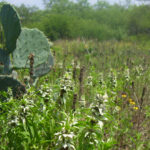In the last post, I spoke of the great and wonderful facts about nitrogen, but (as the wisdom goes) everything in moderation. Nitrogen is essential for plant growth, and its use in fertilizers has dramatically increased agricultural yields worldwide. However, the overuse of nitrogen fertilizers is creating a significant environmental problem with far-reaching consequences. While nitrogen is naturally occurring, the sheer volume we’re now adding to the environment is disrupting natural cycles and causing serious harm.
The Environmental Impact of Excess Nitrogen
When nitrogen fertilizer is applied in excess of what plants can absorb, it doesn’t just disappear. Instead, it enters various environmental pathways, leading to a cascade of negative effects:
- Water Pollution: Excess nitrogen can leach into groundwater and run off into surface waters like rivers, lakes, and oceans. This leads to eutrophication, an over-enrichment of nutrients that fuels excessive algae growth. These algal blooms deplete oxygen in the water, creating “dead zones” where aquatic life cannot survive. Nitrates in drinking water also pose health risks, particularly for infants.
- Air Pollution: Nitrogen fertilizers can release nitrous oxide (N2O), a potent greenhouse gas that’s far more effective at trapping heat than carbon dioxide. This contributes significantly to climate change. Ammonia (NH3) is another gaseous form of nitrogen released from fertilizers. It contributes to smog and acid rain, impacting air quality and harming ecosystems.
- Soil Health Degradation: While nitrogen is essential for plant growth, excessive applications can actually harm soil health in the long run. It can disrupt the delicate balance of soil microorganisms and lead to soil acidification, which can hinder nutrient uptake by plants and make them more susceptible to disease.
- Biodiversity Loss: The changes caused by nitrogen pollution, such as habitat degradation and acidification, can lead to a decline in biodiversity. Some plant species thrive in high-nitrogen environments, outcompeting others and reducing the variety of plant life. This, in turn, affects the animals that depend on those plants.
Why is Overuse Happening?
Several factors contribute to the overuse of nitrogen fertilizers:
- Focus on Yield: Farmers are often under pressure to maximize yields, and nitrogen fertilizer is a powerful tool for achieving this. However, the optimal amount of nitrogen for plant growth is often less than what’s applied, leading to excess.
- Lack of Knowledge or Resources: Some farmers may not have access to information or resources about proper fertilizer application techniques or soil testing.
- Subsidies and Incentives: In some regions, agricultural policies may incentivize the use of fertilizers, even when they’re not necessary.
What Can Be Done?
Addressing the nitrogen problem requires a multi-pronged approach:
- Improved Fertilizer Management: Promoting best practices for fertilizer application, such as soil testing, timing applications to coincide with plant needs, and using slow-release fertilizers, can significantly reduce nitrogen losses.
- Precision Agriculture: Utilizing technology like GPS, sensors, and variable-rate applicators allows farmers to apply nitrogen fertilizer more precisely, based on the specific needs of different areas of their fields.
- Cover Cropping and Crop Rotation: These practices can improve soil health and reduce nitrogen leaching. Cover crops can absorb excess nitrogen and prevent it from running off, while crop rotation can enhance soil fertility naturally.
- Nitrogen-Efficient Crops: Developing crop varieties that are more efficient at utilizing nitrogen can reduce the need for fertilizer applications.
- Policy Changes: Governments can play a role by implementing policies that encourage responsible fertilizer use, such as reducing subsidies for excessive fertilizer application and supporting research on nitrogen-efficient agriculture.
The overuse of nitrogen fertilizer is a complex problem with serious environmental consequences. By understanding the impacts and implementing sustainable agricultural practices, we can work towards a future where food production and environmental health go hand in hand.




